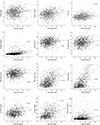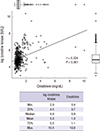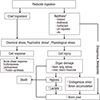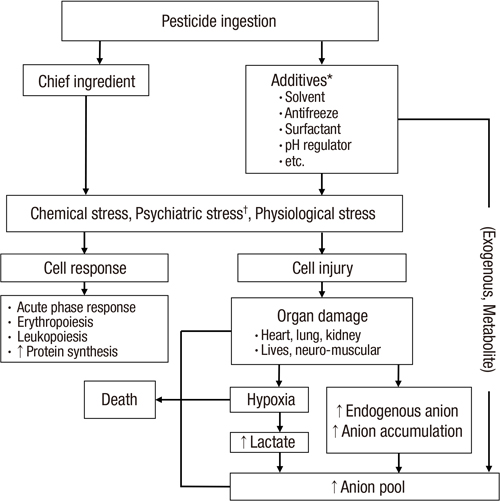1. Weerasinghe M, Konradsen F, Eddleston M, Pearson M, Gunnell D, Hawton K, Jayamanne S, Pabasara C, Jayathilaka T, Dissanayaka K, et al. Risk factors associated with purchasing pesticide from shops for self-poisoning: a protocol for a population-based case-control study. BMJ Open. 2015; 5:e007822.
2. Aggarwal S. Suicide in India. Br Med Bull. 2015; 114:127–134.
3. Gao X, Duan L, Yang C, Ye P, Ji C, Wang Y, Deng X, Jin Y, Er Y, Wang L. Analysis on the characteristics of self-inflicted injury/suicide based on the Chinese National Injury Surveillance System from 2006 to 2013. Zhonghua Liu Xing Bing Xue Za Zhi. 2015; 36:17–19.
4. Cho HD, Kim NY, Gil HW, Jeong DS, Hong SY. Comparison of families with and without a suicide prevention plan following a suicidal attempt by a family member. J Korean Med Sci. 2015; 30:974–978.
5. Moon JM, Chun BJ. Predicting acute complicated glyphosate intoxication in the emergency department. Clin Toxicol (Phila). 2010; 48:718–724.
6. Lee HL, Chen KW, Chi CH, Huang JJ, Tsai LM. Clinical presentations and prognostic factors of a glyphosate-surfactant herbicide intoxication: a review of 131 cases. Acad Emerg Med. 2000; 7:906–910.
7. Gil HW, Jeong MH, Park JS, Choi HW, Kim SY, Hong SY. An outbreak of food borne illness due to methomyl pesticide intoxication in Korea. J Korean Med Sci. 2013; 28:1677–1681.
8. Gil HW, Hong JR, Song HY, Hong SY. A case of methanol intoxication caused by methomyl pesticide ingestion. Hum Exp Toxicol. 2012; 31:1299–1302.
9. Bahrami A, Jonidi-Jafari A, Mahjub H. Environmental exposure to xylenes in drivers and petrol station workers by urinary methylhippuric acid. J Res Health Sci. 2008; 8:61–68.
10. Time oriented score system (TOSS): a method for direct and quantitative assessment of nursing workload for ICU patients. Italian Multicenter Group of ICU research (GIRTI). Intensive Care Med. 1991; 17:340–345.
11. Del Bufalo C, Morelli A, Bassein L, Fasano L, Quarta CC, Pacilli AM, Gunella G. Severity scores in respiratory intensive care: APACHE II predicted mortality better than SAPS II. Respir Care. 1995; 40:1042–1047.
12. Gil HW, Hong JR, Jang SH, Hong SY. Diagnostic and therapeutic approach for acute paraquat intoxication. J Korean Med Sci. 2014; 29:1441–1449.
13. Kitterer D, Schwab M, Alscher MD, Braun N, Latus J. Drug-induced acid-base disorders. Pediatr Nephrol. 2015; 30:1407–1423.
14. Emmett M. Approach to the patient with a negative anion gap. Am J Kidney Dis. 2016; 67:143–150.
15. Gil HW, Yang JO, Lee EY, Hong SY. Clinical implication of urinary neutrophil gelatinase-associated lipocalin and kidney injury molecule-1 in patients with acute paraquat intoxication. Clin Toxicol (Phila). 2009; 47:870–875.
16. Kim SJ, Gil HW, Yang JO, Lee EY, Hong SY. The clinical features of acute kidney injury in patients with acute paraquat intoxication. Nephrol Dial Transplant. 2009; 24:1226–1232.
17. Nozuma S, Okamoto Y, Higuchi I, Yuan J, Hashiguchi A, Sakiyama Y, Yoshimura A, Higuchi Y, Takashima H. Clinical and electron microscopic findings in two patients with mitochondrial myopathy associated with rpisodic hyper-creatine kinase-emia. Intern Med. 2015; 54:3209–3214.
18. Finsterer J, Stöllberger C, Kovacs GG. Asymptomatic hyper-creatine-kinase-emia as sole manifestation of inclusion body myositis. Neurol Int. 2013; 5:34–36.
19. Park JS, Seo MS, Gil HW, Yang JO, Lee EY, Hong SY. Incidence, etiology, and outcomes of rhabdomyolysis in a single tertiary referral center. J Korean Med Sci. 2013; 28:1194–1199.
20. Zhao JL, Baltimore D. Regulation of stress-induced hematopoiesis. Curr Opin Hematol. 2015; 22:286–292.
21. González-Murillo Á, Fernández L, Baena S, Melen GJ, Sánchez R, Sánchez-Valdepeñas C, Segovia JC, Liou HC, Schmid R, Madero L, et al. The NFKB inducing kinase modulates hematopoiesis during stress. Stem Cells. 2015; 33:2825–2837.
22. Zulkifli I, Najafi P, Nurfarahin AJ, Soleimani AF, Kumari S, Aryani AA, O’Reilly EL, Eckersall PD. Acute phase proteins, interleukin 6, and heat shock protein 70 in broiler chickens administered with corticosterone. Poult Sci. 2014; 93:3112–3118.
23. Argente MJ, García ML, Birlanga V, Muelas R. Relationship between cortisol and acute phase protein concentrations in female rabbits. Vet J. 2014; 202:172–175.
24. Kraut JA, Nagami GT. The serum anion gap in the evaluation of acid-base disorders: what are its limitations and can its effectiveness be improved? Clin J Am Soc Nephrol. 2013; 8:2018–2024.
25. Lee JW, Hwang IW, Kim JW, Moon HJ, Kim KH, Park S, Gil HW, Hong SY. Common pesticides used in suicide attempts following the 2012 paraquat ban in Korea. J Korean Med Sci. 2015; 30:1517–1521.












 PDF
PDF ePub
ePub Citation
Citation Print
Print






 XML Download
XML Download